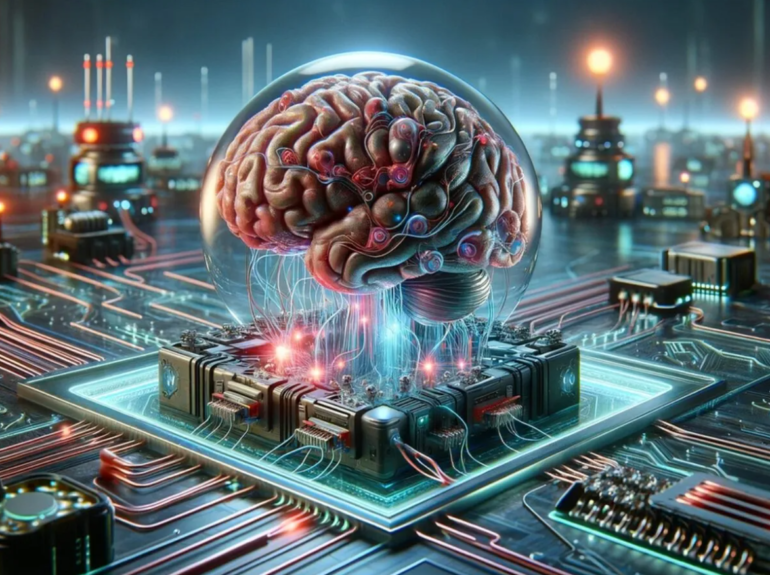TL;DR:
- Brain-inspired hardware, Brainoware, utilizes organoid neural networks (ONNs) to replicate complex brain functions.
- ONNs demonstrate unsupervised learning, a core AI principle, and can be trained for speech recognition.
- Brainoware offers solutions to AI challenges, including energy consumption and heat production.
- Developed by Dr. Feng Guo and Dr. Mingxia Gu, Brainoware’s research was published in Nature Electronics.
- Reservoir computing, the basis of ONNs, excels in processing temporal data with energy efficiency.
- Challenges include the need for incubators, standardized organoid production, and advanced data management.
- Brainoware research provides insights into neural development and cognitive diseases.
- Potential applications include sophisticated and human-like AI systems.
Main AI News:
In the realm of AI, the quest for brain-inspired hardware has led to significant advancements. However, most of these innovations have been rooted in digital electronic principles, constraining their ability to replicate the full spectrum of brain functions. Enter the era of self-organizing brain organoids coupled with microelectrode arrays (MEAs), forming what we now refer to as organoid neural networks (ONNs). These ONNs exhibit remarkable unsupervised learning capabilities, the very foundation of artificial intelligence (AI). Remarkably, when integrated with the right hardware, these miniaturized brain-like structures can be trained to comprehend human speech.
Welcome to the age of “Brainoware,” a groundbreaking computing hardware inspired by the intricacies of the human brain. Brainoware stands poised to address the limitations plaguing existing AI technologies, offering elegant solutions to challenges involving time efficiency, energy consumption, and heat generation, which have long plagued conventional AI hardware. Moreover, these ONNs possess the requisite complexity and diversity to potentially mimic the human brain, offering tantalizing prospects for the development of more sophisticated and human-like AI systems.
The Brainoware project finds its origins in the laboratories of Dr. Feng Guo at Indiana University Bloomington and Dr. Mingxia Gu at Cincinnati Children’s Hospital Medical Center. Their groundbreaking research, detailed in the article titled “Brain organoid reservoir computing for artificial intelligence” in Nature Electronics, charts a path towards a transformative future.
Organoid neural networks (ONNs), as the cornerstone of Brainoware, represent a bio-inspired solution to the challenges of reservoir computing. Reservoir computing, renowned for its unique approach to processing and learning complex temporal and sequential data, has garnered attention for its ability to extract intricate patterns and relationships from temporal sequences. This approach not only ensures swift training but also places a premium on energy efficiency, aligning seamlessly with environmentally conscious AI solutions.
The versatility of reservoir computing has already demonstrated promising outcomes across a multitude of applications, spanning time-series prediction, speech recognition, language modeling, and addressing complex nonlinear dynamical systems. Its innovative architecture and training methodology have carved a niche within the domains of machine learning and artificial intelligence research.
However, the journey to fully brain-inspired computing is not without its challenges. Brainoware, while modest in power consumption, still relies on crucial elements such as incubators and specialized systems managed by skilled cell culture technicians or automated systems to maintain the delicate cell culture. Furthermore, the generation of organoids remains a heterogeneous mix of cell types, both living and deceased. Recent engineering endeavors aimed at enhancing organoid differentiation and growth, along with modifications in their microenvironments, offer the promise of standardized organoid production at scale.
Yet, the technical hurdles do not end there. Effective data management and analysis represent another formidable challenge. Optimization of the encoding and decoding of temporal information to and from Brainoware demands ongoing improvements in data interpretation, extraction, and processing from various sources and modalities. The true potential of Brainoware hinges on the concurrent development of novel algorithms and methodologies for data analysis and visualization.
While the realization of general biocomputing systems may still be decades away, the research journey embarked upon today promises invaluable insights into learning mechanisms, neural development, and the cognitive implications of neurodegenerative diseases. Additionally, it may play a pivotal role in shaping preclinical models for testing novel therapeutics aimed at addressing cognitive impairment. The future of Brainoware is bright, offering a glimpse into a new era of AI and biocomputing possibilities.
Conclusion:
Brainoware, with its organoid neural networks, marks a significant stride in AI hardware development. Its capacity for unsupervised learning and energy-efficient processing of temporal data opens doors to more advanced AI solutions. This breakthrough has the potential to reshape the AI market by offering more natural and efficient alternatives to existing technologies.

